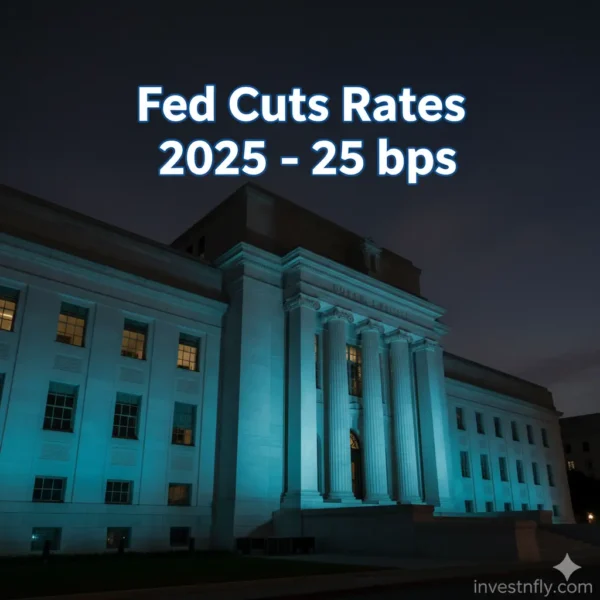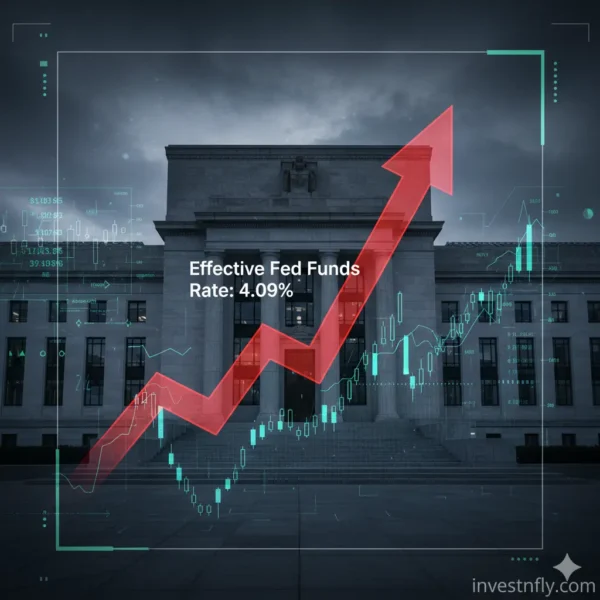Introduction: A Historic Shift in U.S. Banking
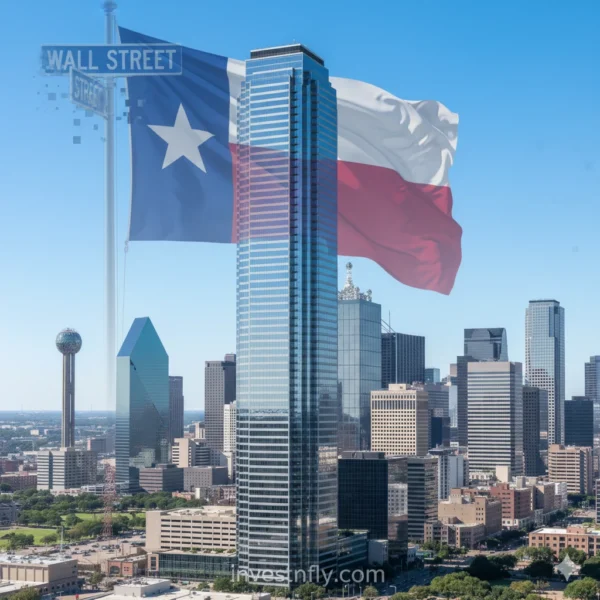
For decades, New York City has been regarded as the undisputed capital of global finance. Wall Street symbolized not only America’s economic strength but also the central hub for banking, investment, and capital markets. However, in 2025, an unexpected shift is reshaping this long-standing narrative. JPMorgan Chase — the largest bank in the United States — now employs more staff in Texas than in New York, marking a symbolic yet powerful transformation in the U.S. finance sector.
This move is not just about jobs or corporate relocation. It signals a broader rebalancing of financial influence within the country. Texas, with its business-friendly tax environment, relatively lower cost of living, and rapidly growing cities such as Dallas, Houston, and Austin, has emerged as an attractive destination for banks and financial institutions. JPMorgan’s decision highlights how major players in the industry are adapting to new economic realities, decentralizing from traditional hubs like New York and seeking growth opportunities elsewhere.
The implications of this development are profound. By surpassing New York in headcount, Texas is no longer just a regional banking outpost — it is quickly evolving into a national financial powerhouse. Analysts suggest this shift could redefine investment flows, corporate strategies, and even policymaking in the years to come. At the same time, it raises questions about Wall Street’s long-term dominance: Can New York maintain its global prestige while financial capital spreads across multiple states?
As the finance industry grapples with rapid technological innovation, regulatory shifts, and changing workforce dynamics, JPMorgan’s Texas expansion is seen as a landmark moment — one that could set the tone for the next decade of American banking.
Why Texas Is Emerging as a Finance Hub
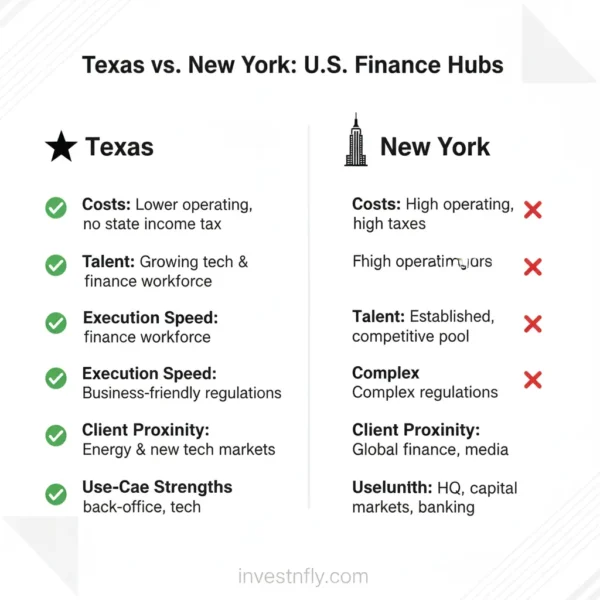
Texas has quietly built the fundamentals that large banks and capital-markets firms care about: predictable costs, regulatory clarity, and a deepening talent pipeline. Three forces stand out.
(a) Structural cost advantages
Texas offers lower corporate and personal tax burdens, cheaper Class-A office space, and lower total compensation pressure versus legacy hubs. For universal banks, this directly improves cost-to-income ratios and gives room to invest in platforms (risk, data, payments) without bloating opex.
(b) Business-friendly policy & speed of execution
Permitting, expansions, and campus builds move faster. Banks can consolidate operations (ops, tech, compliance, risk analytics, payments back-office) in one metro, reducing fragmentation and vendor overhead. Faster execution = quicker product rollouts and a tighter feedback loop with clients.
(c) Diversified, growing talent pool
Dallas–Fort Worth, Austin, and Houston now produce a steady stream of finance, data science, and cyber talent—fueled by universities and a strong tech base. For banks scaling AI/ML in underwriting, fraud, AML, and treasury optimization, this co-location of finance + tech talent is a big edge.
(d) Connectivity to real-economy clients
Texas concentrates energy, industrials, logistics, healthcare, and fast-growing SMB ecosystems. Proximity helps wholesale/transaction banking, cash management, equipment finance, and capital markets origination—translating into stronger fee income and scalable deposits.
(e) Portfolio & risk diversification
Distributing headcount beyond a single coastal hub reduces operational, regulatory, and geo-concentration risks. For SIFI banks, multi-hub footprints are now a board-level resilience priority.
(f) Quality of life & retention
Lower housing costs and commute times improve employee retention, cutting silent costs (recruiting, ramp time, productivity drag). Lower churn = more stable client coverage and ops quality.
Bottom line: Texas isn’t replacing New York’s global market role; it’s becoming the operations + tech + commercial banking powerhouse that underpins profitability and resilience for large institutions.
Impact on Wall Street’s Influence
For more than a century, Wall Street has been the epicenter of U.S. and global finance. From trading floors to investment banks, hedge funds, and private equity firms, New York has defined how the world views American capitalism. But JPMorgan Chase’s expansion in Texas introduces an important question: is Wall Street’s dominance entering a new era of competition?
While Texas is unlikely to dethrone New York as the global capital for capital markets anytime soon, the psychological and strategic impact of this shift is undeniable. When the largest U.S. bank employs more people in Texas than in its traditional headquarters state, it signals that cost efficiency and operational diversification are now as important as proximity to Wall Street’s trading floors.
Analysts believe the move underscores three key points:
- Decentralization of U.S. Finance
Instead of concentrating in a single hub, banks are spreading functions across multiple states. This reduces systemic risks and strengthens business continuity in times of crisis. - Shift in Symbolism and Market Perception
Wall Street has always carried symbolic weight. A shift of headcount and influence to Texas suggests that financial power is becoming more dispersed, challenging the long-standing “Wall Street = finance” narrative. - Competitive Advantage for Texas
By offering cheaper operations and direct access to real economy sectors like energy and logistics, Texas could attract more wholesale and retail banking operations. Over time, this could draw institutional investors and fintech innovators to the state.
In short, Wall Street’s grip on the American finance industry is not broken, but it is being reshaped. New York retains its strength in trading, investment banking, and global deal-making, while Texas is emerging as the operations, technology, and growth engine. Together, they may form a dual power structure — a scenario the U.S. finance sector has not witnessed before.
Wall Street vs Texas: Finance & Insurance Jobs (Latest Available, 2024)
Broader Implications for the U.S. Finance Sector
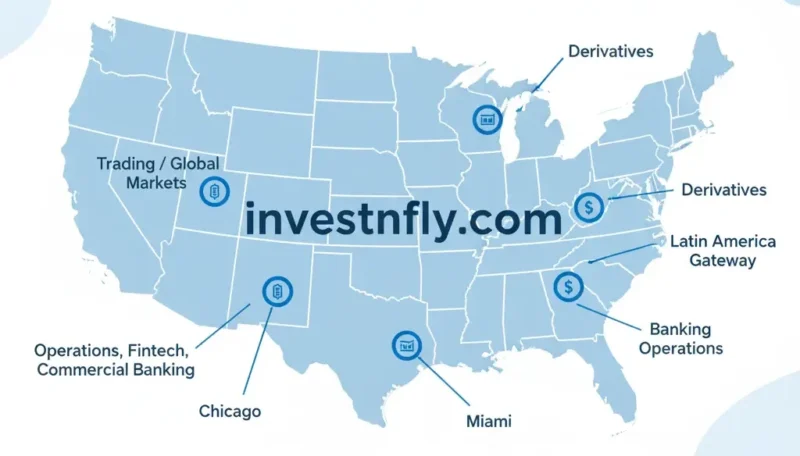
The decision by JPMorgan Chase to expand heavily in Texas does not affect one bank alone; it represents a structural evolution in how the U.S. finance industry distributes its power, talent, and capital. For decades, the system has revolved around a single center of gravity — New York’s Wall Street. Today, that model is slowly transforming into a dual-hub structure, where Texas complements New York as a second anchor point for financial services.
A Dual Finance Capital Model
New York will likely remain the heart of global trading, investment banking, and deal-making, but Texas is positioning itself as the operations, fintech, and commercial banking powerhouse. Together, these two centers could balance efficiency with prestige, creating a more resilient national framework.
Capital Allocation and Investment Flows
As banks and financial firms strengthen their presence in Texas, investment flows are expected to follow. Private equity, venture capital, and institutional investors are showing increased interest in the region’s energy, logistics, healthcare, and technology sectors. This could accelerate growth in local economies while reducing the over-reliance on Wall Street for capital access.
Urban Development and Real Estate
The expansion has also created ripple effects in commercial real estate. Dallas and Houston’s office leasing markets have gained momentum, while New York faces the challenge of rising vacancies. This geographic redistribution of finance jobs may reshape skylines, rental trends, and infrastructure priorities.
Policy and Oversight Challenges
For regulators such as the Federal Reserve, FDIC, and OCC, a multi-hub banking system adds complexity. While geographic diversity spreads risk and boosts stability, it also demands broader supervisory capacity. Compliance and regulatory monitoring will need to adapt to this new reality.
Talent and Education
Texas universities are stepping into the role once dominated by Ivy League schools, supplying fresh talent to the financial sector. Over time, this could transform the pipeline of future bankers, analysts, and fintech innovators.
Investor Confidence
Finally, global investors interpret the Texas expansion as a signal of resilience and adaptability. A distributed system is less vulnerable to shocks concentrated in one city. Still, the prestige of “Wall Street” may gradually share the spotlight with Texas, redefining how the world views American finance.
What It Means for Banks and Investors
📊 Comparison Table
| Impact Area | Banks | Investors |
|---|---|---|
| Operational Strategy | Lower costs, broader talent pool, reduced concentration risk | Signals efficiency and resilience in U.S. finance sector |
| Risk Management | Multi-hub model spreads operational and regulatory risks | Lower systemic risk perception improves confidence |
| Market Opportunities | Closer to real economy clients (energy, logistics, healthcare) | Access to emerging fintech and venture capital activity |
| Short-Term Outlook | Adjustment costs, compliance challenges | Market watching cautiously during transition |
| Long-Term Outlook | Stronger resilience, diversified presence | Confidence in dual-hub finance model (NY + Texas) |
⭐ Why It Matters
- Banks slash costs & gain speed 🏦 → Texas = cheaper real estate, lower taxes, faster permits. Less overhead = more profit margin.
- Proximity = Profit ⚡ → Sitting next to energy giants, tech startups, and logistics firms gives banks a direct pipeline to high-value clients.
- Dual-hub = Safer system 🛡️ → No more “all eggs in Wall Street’s basket.” Multi-hub operations mean less risk if one city faces disruption.
- Investors smell resilience 💹 → Diversification boosts confidence; a shock in NYC won’t shake the entire system anymore.
- Fintech magnet 🤖 → Texas is pulling in fintech founders, VCs, and institutional money, making it a growth lab for financial innovation.
- Short-term pain, long-term gain ⏳ → Relocation headaches today, but a stronger, more balanced finance sector tomorrow.
Expert Opinions and Market Reactions
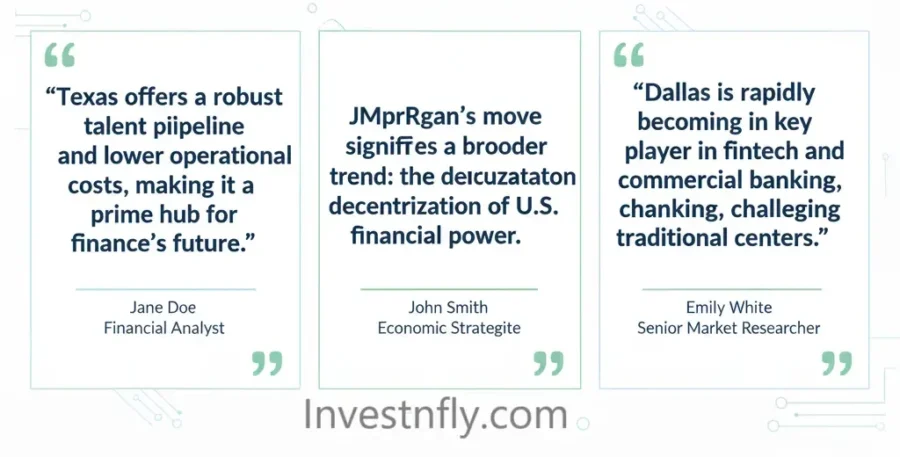
The finance world has been quick to react to JPMorgan Chase’s Texas expansion. Analysts, investors, and regulators see the move as both an opportunity and a challenge for America’s financial system.
🔎 What Analysts Are Saying
- “This is the biggest symbolic shift in U.S. banking since the 2008 crisis,” says Michael Grant, Senior Analyst at FinEdge Research. “It doesn’t mean Wall Street is losing relevance, but it does mean banks are no longer bound to one city.”
- Sarah Liu, a banking strategist at CapitalView Partners, highlights cost benefits: “Texas offers operating efficiencies New York can’t match anymore. Lower costs mean higher margins, and that’s a direct win for shareholders.”
- Daniel Ortiz, professor of finance at UT Austin, points to long-term implications: “With Texas rising, we may be looking at a dual-finance capital model for the first time in U.S. history.”
📈 Investor Sentiment on the Move
Markets have responded with cautious optimism. While JPMorgan’s stock didn’t spike dramatically, investor notes from major brokerages indicate that diversification into Texas is seen as a positive for long-term stability. Portfolio managers view the move as insurance against over-reliance on New York real estate and labor costs. Some investors, however, warn about execution risk — relocating thousands of roles and maintaining compliance standards across hubs is not without friction.
🏦 Regulatory Viewpoint
Regulators have also weighed in. A former FDIC chair commented that the expansion “reduces concentration risk but complicates supervisory oversight.” Federal agencies may need to coordinate more closely across regions, especially as Texas gains influence in wholesale banking, payments, and fintech innovation.
Challenges Ahead for Texas as a Finance Hub
While JPMorgan Chase’s expansion into Texas is a landmark moment, it doesn’t mean the Lone Star State’s rise as a finance hub will be without hurdles. Analysts caution that several structural, reputational, and operational challenges could slow the momentum if not addressed properly.
1. Infrastructure Strain 🚧
Texas cities like Dallas and Austin are already facing housing shortages and rising rental prices due to tech sector growth. An influx of thousands of finance jobs will put additional pressure on housing, transportation, and public infrastructure. Without adequate urban planning, this rapid expansion could become a bottleneck.
2. Global Credibility 🌍
New York’s prestige as a global finance capital comes from decades of history, international recognition, and regulatory influence. Texas, despite its growth, lacks the international reputation of Wall Street or London. Convincing global investors, sovereign funds, and multinational corporations to treat Texas as an equal will take years of consistent performance.
3. Regulatory Complexity 🏦
As more banks expand operations in Texas, regulators like the Federal Reserve and FDIC will face the challenge of overseeing a geographically distributed financial system. Compliance, anti-money laundering (AML), and cybersecurity standards must remain consistent across hubs — a difficult balancing act as operations decentralize.
4. Talent & Retention 🎓
Texas has a growing pool of university graduates and tech workers, but building deep expertise in areas like derivatives, M&A advisory, and global capital markets will take time. Retaining top talent in competition with New York’s legacy institutions could be a challenge.
5. Cultural Integration ⚖️
Texas is business-friendly, but its culture of deregulation and speed may clash with the conservative, risk-averse DNA of big banks. Managing this cultural balance will be critical to success.
Bottom Line: Texas has the momentum, but turning it into long-term dominance will require investment in infrastructure, credibility, and talent pipelines. Without this foundation, the expansion risks being seen as cost-cutting rather than true transformation.
Comparison: Texas vs Other Emerging
Texas may be the headline story, but it’s not the only state making moves in the U.S. financial landscape. Several other cities are carving out niches, though none have yet matched Texas’ momentum.
1. Miami – Gateway to Latin America 🌴
Miami has become a hotspot for wealth management and crypto ventures. Its proximity to Latin America makes it attractive for private banks, family offices, and fintech firms targeting cross-border trade and remittances. However, Miami remains smaller in scale and more dependent on niche sectors compared to Texas.
2. Charlotte – Traditional Banking Stronghold 🏦
Charlotte, North Carolina, is home to Bank of America’s headquarters and a robust retail banking ecosystem. It has long been America’s “second banking city,” but growth has been steady rather than explosive. Unlike Texas, Charlotte lacks the diversified industry base (energy, tech, logistics) that strengthens financial opportunities.
3. Chicago – Derivatives & Trading Capital 📊
Chicago continues to dominate in futures, commodities, and derivatives trading. The CME Group and CBOE keep the city relevant on the global stage. Yet, its strength is concentrated in a single area, whereas Texas is building a full-service hub spanning operations, commercial banking, and fintech.
4. Other Challengers ⚡
Cities like Atlanta, Denver, and Phoenix are also growing in payment systems, fintech, and regional banking, but they remain secondary compared to Texas’ scale.
Why Texas Leads the Pack:
- Diversified industries (energy, healthcare, tech) attract multiple types of finance.
- Cheaper costs + faster expansion speed than East Coast hubs.
- Symbolic win with JPMorgan headcount surpassing New York.
Bottom Line: While Miami, Charlotte, and Chicago remain important players, Texas is the only state that combines cost advantages, industry diversity, and global attention — positioning itself as the true challenger to New York’s dominance.U.S. Finance Hubs
Long-Term Outlook: Is Wall Street Losing Its Crown?
Wall Street has been synonymous with American finance for over a century, and its global prestige will not vanish overnight. New York still dominates in capital markets, global trading, investment banking, and M&A deals — areas that require deep networks and international trust. However, JPMorgan’s Texas expansion signals that the U.S. may be heading toward a dual-hub future.
In the next 5–10 years, analysts expect Texas to cement its position as the operations and innovation engine of U.S. banking. With a strong base in energy finance, fintech, and corporate banking, Texas will complement New York rather than replace it. For global investors, this dual-hub structure could enhance systemic resilience, ensuring that America’s financial leadership remains secure even if one city faces disruption.
Still, there are risks. New York’s symbolic role is so entrenched that global clients may hesitate to treat Texas as an equal player. Success will depend on whether Texas can sustain growth beyond cost advantages and build international credibility in the way London or Hong Kong did over decades.
Bottom Line: Wall Street isn’t losing its crown yet, but Texas is polishing a throne of its own. Over time, the two may co-rule America’s finance sector, with New York handling the deals and Texas driving the growth.
Conclusion: A Defining Moment for U.S. Finance
JPMorgan Chase’s decision to employ more people in Texas than New York is more than a headcount shift — it’s a symbolic turning point for U.S. finance. For decades, New York stood unchallenged as the financial capital of the nation. In 2025, Texas has emerged as a credible challenger, reshaping how banks, investors, and regulators view the future.
This expansion underscores three truths:
- Efficiency matters — Texas offers cost advantages New York can’t match.
- Resilience matters — spreading finance across multiple hubs lowers systemic risk.
- Growth matters — proximity to energy, tech, and logistics industries makes Texas fertile ground for innovation.
Rather than displacing Wall Street, Texas is becoming its strategic partner — a second engine powering America’s financial jet. Together, they represent a stronger, more balanced system capable of facing global challenges.
Final Note: 2025 may be remembered as the year the U.S. finance sector began its evolution from a single-centered empire into a dual-capital powerhouse. For banks, investors, and policymakers, the message is clear: the future of American finance will be written in both New York and Texas.

